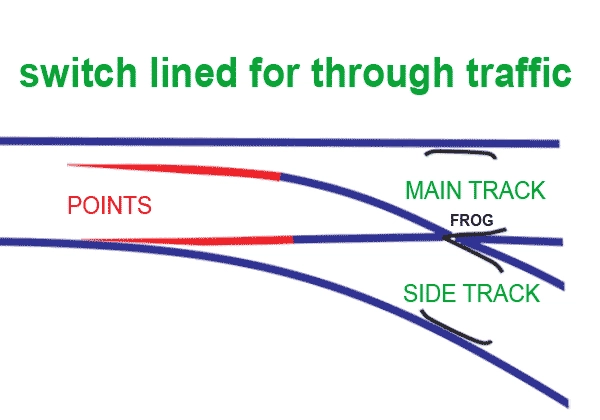How A Track Switch Works

The railroad switch is a marvel of engineering. The ability to smoothly divert a fast moving train from one track to another is really what makes railroading possible.
How you get from here to there
A switch creates two tracks: The main track and a side track turning either left or right. The photo above is a right-hand turnout.
The heart of a switch is a pair of tapered rails called points which lie between the running rails and are slightly narrower in gauge. The points are hinged at one end and are controlled at the sharp end by a connection rod from the switch stand next to the track. When the switch stand lever is thrown, the points move from one running rail to the other. As the points move from side to side, a pair of sign plates (called targets) on the switch stand turn 90 degrees. Traditionally, the targets have consisted of one green plate and one red plate. The targets can be seen from either end of the switch, but only one color is visible at a time. The color of the target indicates the position of the switch: Green for the main track and red for the side track.

At the other end of the switch, where the main track separates from the side track, a “V”-shaped steel casting creates a gap on either side of the “V” to permit wheels to pass through on either track. This section of the switch is called “frog” because it resembles frog legs.

When the switch points are moved, a 5-inch gap is created alongside one of the running rails. This gap permits the wheel of the car or locomotive to go straight through the switch on the main track or into the turnout.

Looking at the switch from both ends
The view is very different from the two ends of the switch
POINTS END – Lined for Main Track

This is a left-hand switch which as been “lined” or positioned for travel through the switch on the main track in both directions. The green target indicates “through travel.” Note the gap between the right-hand point and its rail. The gap guides the wheels of the train along the main track rails. Normally a switch is kept positioned for main track travel.
FROG END – Lined for Main Track

The other end of the left-hand switch is shown above. (Note that everything is reversed: The main track is now on the left and the side track is on the right). From this distance it is often difficult to see how the points at the other end of the switch are positioned. Thus, the worker must depend on the color/shape of the switch targets to know whether the switch is lined for main track through-travel, or for movement in and out of the turnout. In this case, the green target indicates that traffic can only proceed on the main track in either direction.
POINTS END – Lined for Side Track

Now, this left-hand switch has been “lined” or positioned for movement into the side track. There are two ways to know this. The gap between the left-hand point and its rail guides the rail car wheels along the curve of the turnout. The red target confirms that the switch has been lined for a turnout.
FROG END – Lined for Side Track

The red target indicates that the switch has been positioned for in and out movement on the side track. No main track movement is possible through the switch.
If you go through a switch that is lined against movement on your track, you risk derailment and damage to the switch.
How to read switch points
Mind the Gap
Always check to see if the positioning of the switch points agrees with the switch target.
Here’s how:Stand facing the switch points and look for the gap between the one point and its running rail.
Run your eye along that rail and follow it through the switch; this is the way the wheels will go. Then ask yourself, “Is this the direction I want the train to go?”

